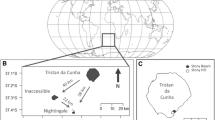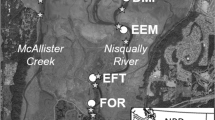Habitat selection by tufted ducks (Aythya fuligula), a diving duck which swallows benthic prey organisms, was studied during winter at two neighboring lagoons (Lakes Nakaumi and Shinji, Honshu, Japan) which differ strongly in their benthic fauna and in their diving duck densities. The ducks fed overwhelmingly on the dominant bivalve found in each of the two lagoons, the mussel Musculista senhousia in L. Nakaumi and the clam Corbicula japonica in L. Shinji. In general, however, the ducks probably preferred the mussels to the clams because of: (i) their high (2.9 times) calorific content for their weight; (ii) their high digestibility; (iii) their greater accessibility; and (iv) their shorter handling time. An average tufted duck (850 g) was estimated to require 1.3 kg of mussels or 3.8 kg of clams to meet their daily energy requirements. As a result, the two wintering populations were estimated to consume 4970 t mussels and 4770 t clams during a single wintering season, amounting to some 20% of the standing clam crop. Throughout the winter the average gizzard weight (37 g), and gizzard–body mass ratio (4.2%) of the Lake Nakaumi population were half those of the Lake Shinji population (73 g, 8.1%, respectively), despite their significantly similar nutritive body condition (% body lipid > 12%). The need to maintain a specialized gizzard mass in order to be able to cope with the different prey species results in little opportunity for ‘sampling’ movements of birds between lakes/prey types and as a result two subpopulations of ducks are indicated to be segregated.
Similar content being viewed by others
REFERENCES
Ankney C. D. (1977) Feeding and digestive organ size in breeding Lesser Geese. Auk 94: 275–282.
Barnes G. G. & Thomas V. G. (1987) Digestive organ morphology, diet, and guild structure of North American Anatidae. Canadian Journal of Zoology 65: 1812–1817.
Blums P., Mednis A., Bauga I., Nichols J. D., Hines J. E. (1996) Age-specific survival and philopatry in three species of European ducks: A long-term study. Condor 98: 61–74.
BMRC (Bird Migration Research Center, Yamashina Institute for Ornithology). (1994) Report of the Bird Migration Research Center, 1993. Yamashina Institute for Ornithology, Abiko (in Japanese).
BMRC (Bird Migration Research Center, Yamashina Institute for Ornithology) (1995) Report of the Bird Migration Research Center, 1994. Yamashina Institute for Ornithology, Abiko (in Japanese).
Chiba K. (1977) On the ecology of the bivalve Musculus senhousia. Marine Science Monthly 9: 13–17 (in Japanese with an English summary).
Cody M. L. (1974). Competition and the Structure of Bird Communities. Princeton University Press, Princeton.
Cooper J. (1980) Energetic requirements for maintenance of a captive juvenile Great White Pelican Pelecanus onocrotalus. Cormorant 8: 17–19.
Cramp S. & Simmons K. E. L.,eds. (1977). Handbook of the Birds of Europe, the Middle East and North America, Vol. 1. Oxford University Press, Oxford.
Crooks J. A. (1996) The population ecology of an exotic mussel, Musculista senhousia, in a Southern California Bay. Estuaries 19: 42–50.
Custer C. M., Custer T. W., Sparks D. W. (1996) Radio telemetry documents 24-hour feeding activity of wintering Lesser Scaup. Wilson Bulletin 108: 556–566.
Draulans D. (1982) Foraging and size selection of mussels by the tufted duck, Aythya fuligula. Journal of Animal Ecology 51: 943–956.
Draulans D. (1984) Sub-optimal mussel selection by Tufted Ducks Aythya fuligula test of a hypothesis. Animal Behaviour 32: 1192–1196.
Drobney R. D. (1984) Effect of diet on visceral morphology of breeding Wood Ducks. Auk 101: 99–102.
EAJ (Environment Agency of Japan), eds. (1993) The Fourth Natural Environment Survey in Japan—Data Book of Lakes in the Western Japan. EAJ, Tokyo (in Japanese).
EAJ (Environment Agency of Japan), eds. (1995) The Report on the 26th Annual Census of Waterfowls (Anatidae) in January 1995. EAJ, Tokyo (in Japanese).
EAJ (Environment Agency of Japan), eds. (1997) The Report on the 28th Annual Census of Waterfowls (Anatidae) in January 1997. EAJ, Tokyo (in Japanese).
Gaunt A. S., Hikida R. S., Jehl Jr J. R., Fenbert L. (1990) Rapid atrophy and hypertrophy of an avian flight muscle. Auk 107: 649–659.
Goudie R. I. & Ryan P. C. (1991) Diets and morphology of digestive organs of five species of sea ducks wintering in Newfoundland. Journal of Yamashina Institute for Ornithology 22: 1–8.
Guillemette M., Reed A., Himmelman J. H. (1996) Availability and consumption of food by common eiders wintering in the Gulf of St. Lawrence: Evidence of prey depletion. Canadian Journal of Zoology 74: 32–38.
Guillemette M., Ydenberg R. C., Himmelman J. H. (1992) The role of energy intake rate in prey and habitat selection of common eiders Somateria mollissima in winter: A risk-sensitive interpretation. Journal of Animal Ecology 61: 599–610.
Hagemeijer W. J. M. & Blair M. J.,eds. (1997) Tufted duck. In: The EBCC Atlas of European Breeding Birds: Their Distribution and Abundance. pp. 106–107. T. & A. D. Poyser, London.
Hamilton D. J., Ankney C. D., Bailey R. C. (1994) Predation of zebra mussels by diving ducks: An exclosure study. Ecology 75: 521–531.
Ito N. & Kajiwara T. (1981) The ecological study of the mussel, Musculista senhousia, in Yokosuka Harbor, I: Distribution, population changes and total sulphide under the mussel nest. Marine Fouling 3: 37–41 (in Japanese with an English summary).
Kamiya K. & Kunii H. (1998) Seasonal changes in the number of water birds observed in Honjou Area, Lake Nakaumi. Laguna 5: 237–242.
Kawashima T., Suzuki H., Yamane K., Ogawa K. (1989) A result of the survey to estimate Corbicula japonica biomass in L. Shinji. Bulletin of Shimane Prefectural Fishery Experimental Station, Showa 62: 200–203 (in Japanese).
Kehoe F. P. & Ankney C. D. (1985) Variation in digestive organ size among five species of diving ducks (Aythya spp.). Canadian Journal of Zoology 63: 2339–2342.
Kimura R. & Sekiguchi H. (1993) Some aspects of population dynamics of a Mytilid Musculista senhousia (BENSON) on tidal flats. Benthos Research 44: 29–40.
Kira T., ed. (1995). Data Book of World Lake Environments—A Survey of the State of World Lakes—Asia and Oceania. International Lake Environment Committee Foundation, Kusatsu, Nagano, Japan.
de Kock W. C. & Bowmer C. T. (1992) Bioaccumulation, biological effects and food chain transfer of contaminants in the zebra mussel (Dreissena polymorpha). Zebra Mussels: Biology, Impacts, and Control (eds T. F. Nalepa & D. W. Schloesser) pp. 503–536. Lewis Publishers, London.
Kooyman G. L., Davis R. W., Croxall J. P., Costa D. P. (1982) Diving depths and energy requirements of King Penguins. Science 217: 726–727.
Kunii H. (1995) Species diversity of aquatic macrophytes in brackish waters. Japanese Journal of Seawater 49: 136–139.
Lasiewski R. C. & Dawson W. R. (1967) A re-examination of the relation between standard metabolic rate and body weight in birds. Condor 69: 13–23.
de Leeuw J. J. (1996) Diving costs as a component of daily energy budgets of aquatic birds and mammals: Generalizing the inclusion of dive-recovery costs demonstrated in tufted ducks. Canadian Journal of Zoology 74: 2131–2142.
de Leeuw J. J. & van Eerden M. R. (1992) Size selection in diving tufted ducks Aythya fuligula explained by differential handling of small and large mussels Dreissena polymorpha. Ardea 80: 354–362.
Lovvorn J. R. (1994) Biomechanics and foraging profitability: An approach to assessing trophic needs and impacts of diving ducks. Hydrobiologia 279/280: 223–233.
Nakamura M., Yamane K., Mukai T., Matsumoto H., Yasuki S. (1995) Size structure of Corbicula japonica in shell length throughout a year. Bulletin of Shimane Prefectural Fishery Experimental Station, Heisei 5: 163–166 (in Japanese).
Neumann D., Borcherding J., Jantz B. (1992) Growth and seasonal reproduction of Dreissena polymorpha in the Rhine River and adjacent waters. Zebra Mussels: Biology, Impacts, and Control (eds T. F. Nalepa & D. W. Schloesser) pp. 95–109. Lewis Publishers, London.
Oka N. (1998) Prey-predator relationship in shallow water ecosystem. Kaiyo Monthly 30: 289–295 (in Japanese).
Oka N. & Sekiya Y. (1997) A review: Ecology of diving ducks (tufted ducks, pochards, and greater scaups), with particular reference to feeding behaviour and diet. Bulletin of Hoshizaki Green Foundation 1: 85–97 (in Japanese with an English summary).
Piersma T., Koolhaas A., Dekinga A. (1993) Interactions between stomach structure and diet choice in shorebirds. Auk 110: 552–564.
Piersma T. & Lindstrom A. (1997) Rapid reversible changes in organ size as a component of adaptive behaviour. TREE 12: 134–138.
Sawamura T., Nakamura M., Nakao S., Yamane H. (1993) Aquatic environment and benthos community in Lake Nakaumi. Bulletin of Shimane Prefectural Fishery Experimental Station 1991: 201–211 (in Japanese).
Scott D. A. & Rose P. M. (1996). Atlas of Anatidae Populations in Africa and Western Eurasia. Wetlands International, Wageningen.
Secor S. M. & Diamond J. (1995) Adaptive responses to feeding in Burmese pythons: pay before pumping. Journal of Experimental Biology 198: 1313–1325.
Smit H., bij de Vaate A., Reeders H. H., van Nes E. H., Noordhuis R. (1992) Colonization, ecology, and positive aspects of zebra mussels (Dreissena polymorpha) in The Netherlands. Zebra Mussels: Biology, Impacts, and Control (eds T. F. Nalepa & D. W. Schloesser) pp. 55–77. Lewis Publishers, London.
Sokal R. R. & Rohlf F. J. (1981). Biometry, 2nd edn. W. H. Freeman, London.
Stewart R. E., Geis A. D., Evans C. D. (1958) Distribution of populations and hunting kill of the canvasback. Journal of Wildlife Management 22: 333–370.
Tanaka M. & Kikuchi T. (1978) Ecological studies on benthic macrofauna in Tomoe Cove, Amakusa, 2: Production of Musculista senhousia (Bivalvia, Mytilidae). Bulletin of Amakusa Marine Biological Laboratory 4: 215–233.
Thompson D. (1973) Feeding ecology of diving ducks on Keokuk Pool, Mississippi River. Journal of Wildlife Management 37: 367–381.
der Wal R. J. V. D. & Zomerdijk P. J. (1979) The moulting of tufted duck and pochard on the Ijsslmeer in relation to moult concentrations in Europe. Wildfowl 30: 99–108.
Yamamuro M., Inouchi Y., Nishimura K. et al. (1997) Eutrophication control through food web management in estuarine lagoons: A case study of Lake Shinji and Lake Nakaumi. Research Bulletin of Pollution Control of National Institutes 47: 1–14 (in Japanese with an English summary).
Author information
Authors and Affiliations
Corresponding author
About this article
Cite this article
Oka, N., Yamamuro, M., Hiratsuka, J. et al. Habitat selection by wintering tufted ducks with special reference to their digestive organ and to possible segregation between neighboring populations. Ecol Res 14, 303–315 (1999). https://doi.org/10.1046/j.1440-1703.1999.00308.x
Received:
Accepted:
Issue Date:
DOI: https://doi.org/10.1046/j.1440-1703.1999.00308.x




